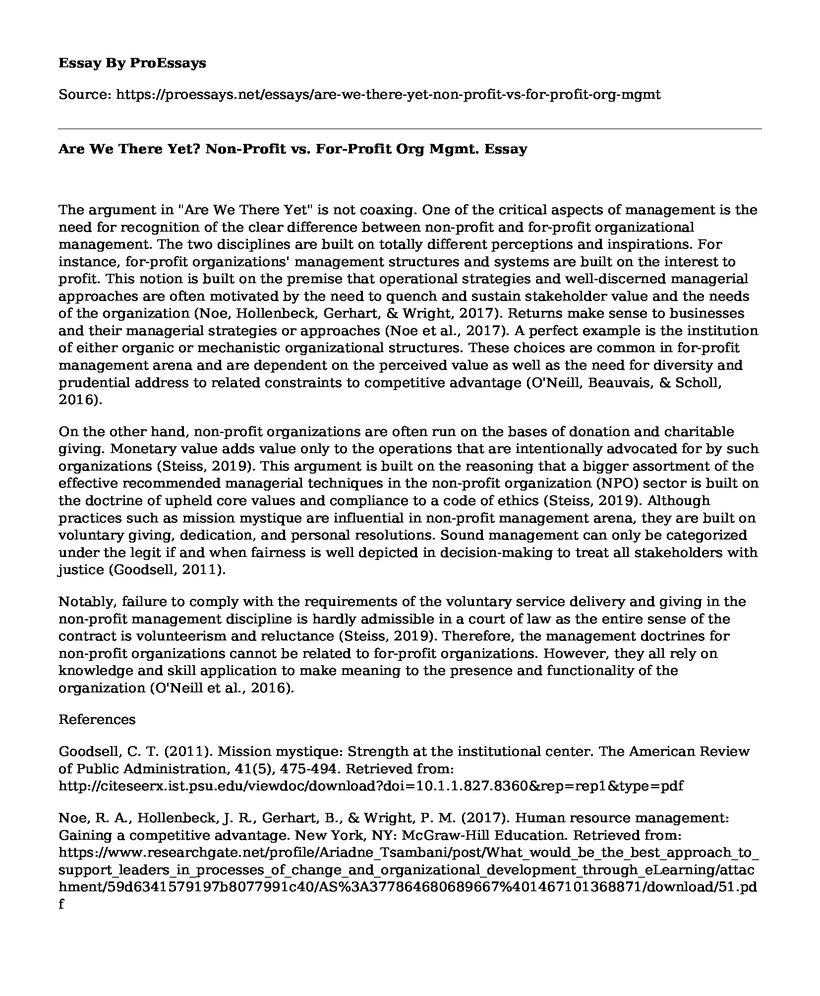The argument in "Are We There Yet" is not coaxing. One of the critical aspects of management is the need for recognition of the clear difference between non-profit and for-profit organizational management. The two disciplines are built on totally different perceptions and inspirations. For instance, for-profit organizations' management structures and systems are built on the interest to profit. This notion is built on the premise that operational strategies and well-discerned managerial approaches are often motivated by the need to quench and sustain stakeholder value and the needs of the organization (Noe, Hollenbeck, Gerhart, & Wright, 2017). Returns make sense to businesses and their managerial strategies or approaches (Noe et al., 2017). A perfect example is the institution of either organic or mechanistic organizational structures. These choices are common in for-profit management arena and are dependent on the perceived value as well as the need for diversity and prudential address to related constraints to competitive advantage (O'Neill, Beauvais, & Scholl, 2016).
On the other hand, non-profit organizations are often run on the bases of donation and charitable giving. Monetary value adds value only to the operations that are intentionally advocated for by such organizations (Steiss, 2019). This argument is built on the reasoning that a bigger assortment of the effective recommended managerial techniques in the non-profit organization (NPO) sector is built on the doctrine of upheld core values and compliance to a code of ethics (Steiss, 2019). Although practices such as mission mystique are influential in non-profit management arena, they are built on voluntary giving, dedication, and personal resolutions. Sound management can only be categorized under the legit if and when fairness is well depicted in decision-making to treat all stakeholders with justice (Goodsell, 2011).
Notably, failure to comply with the requirements of the voluntary service delivery and giving in the non-profit management discipline is hardly admissible in a court of law as the entire sense of the contract is volunteerism and reluctance (Steiss, 2019). Therefore, the management doctrines for non-profit organizations cannot be related to for-profit organizations. However, they all rely on knowledge and skill application to make meaning to the presence and functionality of the organization (O'Neill et al., 2016).
References
Goodsell, C. T. (2011). Mission mystique: Strength at the institutional center. The American Review of Public Administration, 41(5), 475-494. Retrieved from: http://citeseerx.ist.psu.edu/viewdoc/download?doi=10.1.1.827.8360&rep=rep1&type=pdf
Noe, R. A., Hollenbeck, J. R., Gerhart, B., & Wright, P. M. (2017). Human resource management: Gaining a competitive advantage. New York, NY: McGraw-Hill Education. Retrieved from: https://www.researchgate.net/profile/Ariadne_Tsambani/post/What_would_be_the_best_approach_to_support_leaders_in_processes_of_change_and_organizational_development_through_eLearning/attachment/59d6341579197b8077991c40/AS%3A377864680689667%401467101368871/download/51.pdf
O'Neill, J. W., Beauvais, L. L., & Scholl, R. W. (2016). The use of organizational culture and structure to guide strategic behavior: an information processing perspective. Journal of Behavioral and Applied Management, 2(2), 816. Retrieved from: https://jbam.scholasticahq.com/article/816.pdf
Steiss, A. W. (2019). Strategic management for public and non-profit organizations. Abingdon-On-Thames: Routledge. Retrieved from: http://155.0.32.9:8080/jspui/bitstream/123456789/82/1/Strategic%20Management.pdf
Cite this page
Are We There Yet? Non-Profit vs. For-Profit Org Mgmt.. (2023, Jan 25). Retrieved from https://proessays.net/essays/are-we-there-yet-non-profit-vs-for-profit-org-mgmt
If you are the original author of this essay and no longer wish to have it published on the ProEssays website, please click below to request its removal:
- Cost of Capital
- Essay Samples on Sales Taxes for Online Purchases
- Course Work on Management: Leadership Effectiveness
- Critical Theory Approach and Leadership Paper Example
- Essay Example on Samaritan's Purse: Effective Leadership Skill for Organization Administration
- West Jet Airlines' IT Governance
- Essay Sample on Operations Management: Enhancing Productivity & Quality







